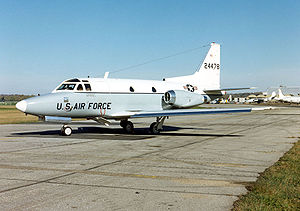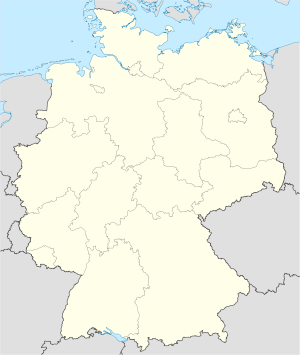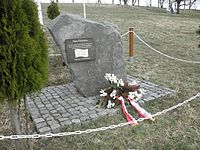- 1964 T-39 shootdown incident
-
1964 T-39 shootdown incident Part of the Cold War 
A T-39 Sabreliner of the U.S. Air ForceDate 28 January 1964 Location Vogelsberg, East Germany Result One aircraft shot down Belligerents  United States
United States Soviet Union
Soviet UnionCasualties and losses Three USAF officers killed None The 1964 T-39 shootdown incident occurred on January 28, 1964, when an unarmed United States Air Force T-39 Sabreliner on a training mission was shot down over Erfurt, East Germany by a Soviet Mikoyan-Gurevich MiG-19 fighter aircraft.[1][2][3]The occupants of the aircraft were Lieutenant Colonel Gerald K. Hannaford, Captain Donald Grant Millard and Captain John F. Lorraine. All three died,[4] becoming some of the few direct casualties of the Cold War.
Contents
Background
Following the cessation of hostilities at the end of World War II, a situation which came to be known as the Cold War developed between the United States, Canada, Western European nations, and the Soviet bloc.[5] Tensions between the United States and Soviet Union were most felt in the regions bordering the Iron Curtain, notably West Germany and East Germany and during this time relations between the two superpowers were characterised by hostile attitudes, spying, and numerous incidents resulting in loss of life and equipment. One of the most famous of these is the shooting down of a Lockheed U-2 spy plane, piloted by Francis Powers, over the Soviet Union in May 1960.[6]
Event
On January 28, 1964, an unarmed USAF T-39 twin engine jet trainer departed Wiesbaden, West Germany, at 14:10 on a routine three-hour training flight. On board the trainer were three men, Captain John F. Lorraine and students Lieutenant Colonel Gerald K. Hannaford and Captain Donald G. Millard. Lorraine was the qualified instructor, while Hannaford and Millard, both pilots with experience on other types, were being trained in order to qualify on the T-39.[4]
The flight proceeded uneventfully until, 47 minutes after takeoff, radar at two U.S. air defense stations noticed a fast-moving blip speeding toward East Germany at 500 mph.[4] Hoping to divert the plane from its misdirected flight, each station began hailing the plane on Air Force frequencies and a Russian-monitored international distress band. Repeated calls to the T-39 went unanswered. It appeared that the T-39's radio systems malfunctioned and the crew were unable to respond.[4]
The T-39 crossed the border into East Germany. Within five minutes, two blips appeared near the American jet. For 11 minutes, radar blips indicated the three planes were moving eastward, then two blips suddenly veered west and one blip disappeared. American personnel monitoring the T-39's flight could not determine what had happened, although it was later reported that residents in Vogelsberg, 50 miles (80 km) from the border, had heard machine-gun and cannon fire and had witnessed the plane crash.[4] The incident is believed to have occurred at 15:14 hours.[2]
At 17:00 hours on January 28 the United States Military Liaison Mission (USMLM), in Berlin, received a warning to stand by for possible search and rescue of American airmen.[2] By 18:00 hours, a search team left Berlin for the Erfurt area of East Germany. At 19:15 hours, the chief of the USMLM met with his Russian counterpart to request help in finding the plane and rescuing survivors (per the Heubner–Malinin Agreement).[2]
At 20:00 hours, a second search team left Berlin. About this same time, the first team arrived at the crash site, 20 kilometers (12 mi) north of Erfurt. The first team received a report from an East German civilian that a U.S. plane had crashed, burned, and the crew was dead.[2] Throughout the night, the American teams tried to approach the aircraft and were repeatedly sent away by the armed Soviet forces on site.[2] These forces denied that any aircraft had crashed, and two American search teams were detained briefly before being released at 14:00 hours on January 29.[2]
Aftermath
By January 29, the United States State Department charged that the Soviet Union shot down an unarmed plane and caused the needless deaths of three officers. Secretary of State Dean Rusk called the action a "shocking and senseless act."[7] Through the Soviet press agency, Tass, Moscow claimed that the plane had intruded over East German territory and failed to react to signals, and then a warning shot. The Soviets said they were compelled to take the measure that brought down the U.S. plane.[4]
On January 30, the Soviets agreed to allow US personnel access to the crash site.[2] This occurred the following day and later the bodies of all three servicemen were returned to the United States through Andrews Air Force Base in Maryland. General Curtis E. LeMay met the plane and participated in an honors ceremony.[8][9] The aircraft wreckage was also recovered and was taken back to Berlin, arriving there on February 1, 1964.[2]
Memorial
Residents from the nearby town of Vogelsberg in Thuringia erected a memorial to the three downed pilots, once the "Iron Curtain" was lifted.[10][11]
See also
- Cold War (1962–1979)
- USA-USSR air-to-air and shotdown incidents
References
- Notes
- ^ "Factsheets : North American T-39A Sabreliner". Nationalmuseum.af.mil. http://www.nationalmuseum.af.mil/factsheets/factsheet.asp?id=573. Retrieved April 13, 2010.
- ^ a b c d e f g h i "T-39 Aircraft Incident". Western-allies-berlin.com. 1964-01-28. http://www.western-allies-berlin.com/units/military-liaison-mission/usmlm/detail/t-39-crash. Retrieved April 13, 2010.
- ^ Aviation Safety Network Retrieved on 27 October 2011
- ^ a b c d e f "Cold War: Cold Blooded Murder". Time. February 7, 1964. http://www.time.com/time/magazine/article/0,9171,870650,00.html. Retrieved April 17, 2010.
- ^ Blainey 2005, pp. 274–277
- ^ Blainey 2005, pp. 344–345
- ^ "Red Attack on U.S. Jet: Three Americans Killed in Unarmed Trainer Crash". The Spokesman Review. January 30, 1964. http://news.google.com/newspapers?nid=1314&dat=19640130&id=d50RAAAAIBAJ&sjid=BekDAAAAIBAJ&pg=6479,5227671. Retrieved April 17, 2010.[dead link]
- ^ "US to Fly Bodies of Airmen Home". The Milwaukee Journal. February 5, 1964. http://news.google.com/newspapers?id=_RweAAAAIBAJ&sjid=Y34EAAAAIBAJ&pg=3092,2204853&dq=shot+down+millard&hl=en. Retrieved April 17, 2010.
- ^ "Soviets Admit Downing U.S. Plane". St. Petersburg Times. January 29, 1964. http://news.google.com/newspapers?nid=888&dat=19640129&id=DRUOAAAAIBAJ&sjid=5HwDAAAAIBAJ&pg=4775,4839495. Retrieved April 17, 2010.[dead link]
- ^ "Cold War Casualties Cry Out For Commemoration". VFW Magazine. May 2004. http://www.vfwmagazine.org/archives2004may.htm. Retrieved April 17, 2010.
- ^ "A Cold Night in Erfurt". www.usmlm.org. http://www.usmlm.org/home/coldwar/shootdowns/1964t39shootdown.htm. Retrieved April 17, 2010.
- References
- Blainey, Geoffrey (2005). A Short History of the 20th Century. Camberwell, Victoria: Viking. ISBN 0670042730.
Further reading
- Olsen, Arthur J., "U.S. Jet Lost in East Germany; It May Have Been Shot Down", The New York Times, January 28, 1964.
- Raymond, Jack, "U.S. Says Soviet Shot Down Jet", The New York Times, January 29, 1964.
Coordinates: 51°07′09.56″N 11°14′00.42″E / 51.1193222°N 11.23345°ECategories:- Aircraft shootdowns
- Cold War
- Diplomatic incidents
- Inner German border
- Soviet Union–United States relations
- 1964 in Germany
- 1964 in the Soviet Union
- 1964 in the United States
- 1964 in East Germany
- Accidents and incidents involving United States Air Force aircraft
- Air-to-air combat operations and battles
Wikimedia Foundation. 2010.


